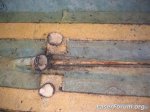Cupcake
PaddleHand
Anyone out there tried squirting any kind of foam bonding adhesive down through an inspection port to bond the cockpit and the hull together to prevent movement between hull and footwell/cockpit? I would like to add just one port rather than two and try to get epoxy/resin/cloth down in there.
thanks!
thanks!



